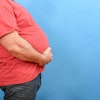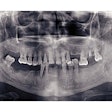
Obese patients are at increased risk for periodontal disease compared to patients of normal weight, according to a study presented at the recent International Association for Dental Research (IADR) meeting in Miami.
A team of investigators from the Harvard School of Public Health and the University of Puerto Rico evaluated the association between different measures of obesity and risk of periodontal disease.
“Dentists can play an important role in providing education to patients with respect to the role systemic health can have on their oral health and vice versa.”
— Monik Jimenez, Harvard School of
Public Health
The researchers examined data from 36,903 men who participated in the Health Professionals Follow-Up Study. The men were free of reported periodontal disease at the start of the study, which followed them for up to 16 years between 1986 and 2002.
At the start of the study, researchers collected data on the subjects' height, weight, and self-reported periodontal disease. The same information was then collected on follow-up questionnaires every two years. Central obesity was measured through self-assessed measurement of waist and hip circumference using printed instructions and a tape measure.
The researchers evaluated the effect of body mass index (BMI, kg/m²), waist circumference, and waist-to-hip ratio on the first report of periodontal disease diagnosis.
Overall, 3,340 new periodontal disease diagnoses were reported.
The team observed significant associations between obesity and periodontal disease after adjusting for age, smoking, race, dental profession, physical activity, fruit and vegetable intake, and diabetes status at baseline.
Among the findings:
- Obese men with a BMI of 30 or higher were at significantly higher risk for periodontal disease compared to men with a lower BMI.
- Men with a waist circumference of 40 inches or more had a significantly higher incidence of periodontal disease compared to men with waists less than 40 inches.
- Men with a waist-to-hip ratio of 0.95 or more exhibited a significant positive association with incidence of periodontal disease compared to those with a lower waist-to-hip ratio.
"These results provide the first prospective evidence to support an association between obesity and risk of periodontal disease," the study authors wrote. "Given the high prevalence of excess adiposity and periodontal disease, this association may be of substantial public health importance."
This study is unique because all previous inquiries into this matter have been cross-sectional, while this one was longitudinal, evaluating the association over many years, said Monik Jimenez, a doctoral candidate at the Harvard School of Public Health and one of the study authors, in an interview with DrBicuspid.com.
"Therefore, we could establish that the obesity preceded periodontal disease," she said.
While she and her colleagues did not evaluate the mechanisms that link the two conditions, there are several possibilities, Jimenez said.
One potential mechanism is inflammation. Obesity leads to low-grade inflammation and increased circulating levels of proinflammatory cytokines that may promote periodontal disease through periodontal tissue destruction and bone resorption, she said.
Another possibility is dyslipidemia, which may alter immune response and thereby lead to tissue destruction. Finally, Jimenez said, there is insulin resistance. The association between obesity and insulin resistance is well established, and insulin resistance may lead to decreased wound healing and increased disease severity, she explained.
Dentists need to stay well informed of the literature, Jimenez added, especially when the evidence suggests, as in this case, that obese patients are at increased risk of periodontal disease.
"Dentists can play an important role in providing education to patients with respect to the role systemic health can have on their oral health and vice versa," she concluded.
The study manuscript is currently being prepared for publication.
Copyright © 2009 DrBicuspid.com



















